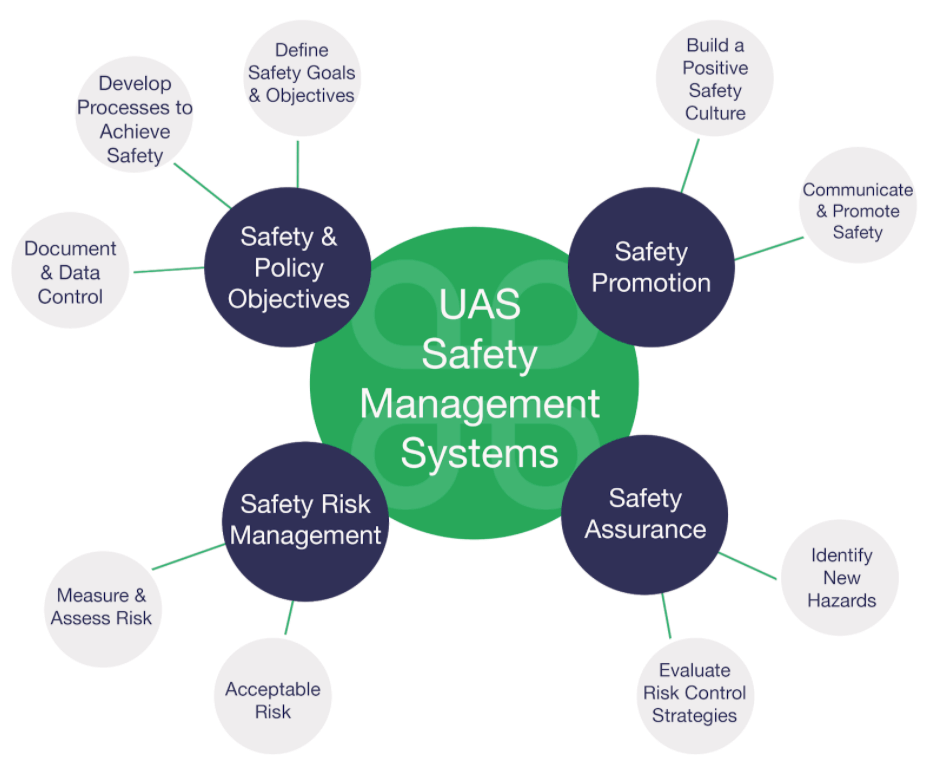Nov. 2, 2020
Safety management systems (SMS) have been a core piece of aviation compliance and best practices for decades. As commercial drone programs across industries have developed over recent years, adopting SMS for uncrewed operations was a natural evolution of SMS, albeit not a perfect fit given the unique nature of UAS (Unmanned/Uncrewed Aircraft Systems) or drone technology and a new set of risk factors. While many of the philosophies and core tenets of SMS translate from traditional aviation to UAS, the specifics do not. For example, one of the biggest risk elements for traditional aviation involves runways, but that has no place in most UAS operations.
NBAA’s Emerging Technologies Committee will be developing content, analysis and resources for applying SMS to all types of UAS operations, from inspection use cases under Part 107 to Advanced Air Mobility (AAM) and delivery use cases.
This introductory resource sets the stage for what SMS is and how it can align with your UAS program.
SMS for Uncrewed Aircraft
Traditionally, an SMS consists of four main components: safety policy, safety assurance, safety risk management and safety promotion.

Safety Policy
Safety policy should align the organization’s goals and values with procedures and metrics. It should define safety performance objectives, show clear roles and responsibilities, as well as ways to ensure maximum compliance and accountability in normal operations and emergencies.
Safety Assurance
Safety assurance is a means of demonstrating that performance is measured, compliance is monitored and procedures are in place to keep the SMS up to date and working as designed.
Safety Risk Management
Safety risk management involves the forecasting, identification and evaluation of risks, together with designing and implementing procedures to avoid or minimize the impact of these risks.
Safety Promotion
Safety promotion involves developing processes to sustain and improve safety through awareness and changing behaviors, including communication, training, education and transparency.
Practical Steps to Implement an SMS
Once you have decided to implement an SMS, what practical steps can you take for each of the four components? A successful SMS combines thought-out goals and objectives with policies and procedures designed to achieve those results.
Key Takeaways for Growing Enterprise UAS Programs
Develop a simple-to-follow and execution-oriented safety policy.
Making your safety policy execution-oriented, especially for flight operations, should mean higher engagement with your safety policy and easier expectation management. A safety policy should be reviewed periodically and updated accordingly. Everyone is a stakeholder, but in enterprise UAS programs, your UAS program manager is the person who is ultimately responsible for the overall success and safety of the program.
Establish data-driven safety risk management practices.
Your enterprise UAS program’s safety risk management (SRM) strategy should minimize the use of emotional/gut decisions through quantifying risks. By quantifying risks, you can decide on an acceptable level of risk for your operations and build that into your safety practices. Good SRM will make clear what acceptable levels of risk are and how to stay within those limits. Make it easy to identify operational hazards by implementing checklists for multiple purposes to ensure airspace and operational compliance of every flight.
Implement an improvable and adaptable safety assurance plan.
A good safety assurance process will provide a roadmap for improving itself and responding to both anticipated and unanticipated challenges. It should provide stakeholders with near real-time knowledge of safety assurance data and how their SMS is performing. A key element of the safety assurance process is understanding how your organization’s telemetry, sensor and live-stream data will be protected. A good safety assurance plan with a good safety culture encourages and includes reporting normal and abnormal incidents. Audits, performance reviews or retros help drive this process.
Create a safety promotion culture.
Developing a culture of safety is a major driver of safety promotion in your enterprise UAS program. An organization can establish and promote a positive safety culture by encouraging communication and transparency within the UAS program. Sub-optimal participation means sub-optimal safety. Less data to work with means less analysis being done. Without adequate safety promotion, other elements of an SMS are more likely to fail.
Key Takeaways for Small/Medium Business UAS Programs
Adopt improvable and adaptable SMS practices.
Smaller organizations should make their SMS flexible for growth and changes. As smaller organizations are more nimble, they can change course quickly if a practice or principle is tried and does not work.
Make it easy to comply with your organization’s SMS.
The reality for small organizations is you have to “wear multiple hats” and can’t devote as much time to anyone’s project or function. As with any organization, it’s important to strike the right balance between formal and informal processes as your UAS program grows.
Give employees the right information when they need it.
Smaller programs (and organizations of all sizes) can suffer from information overload. To create an effective SMS for your small/medium business, procedures should prioritize surfacing the right information at the right time.
Establish open communication about safety.
If you’re testing out a new safety risk management practice, such as a risk assessment checklist, it is important to make sure your pilots and participants in UAS operations understand the purpose of this new practice. Once the operations are complete, a good practice is to debrief with the pilots for feedback on this new practice.


 International Business Aviation Council Ltd.
International Business Aviation Council Ltd.